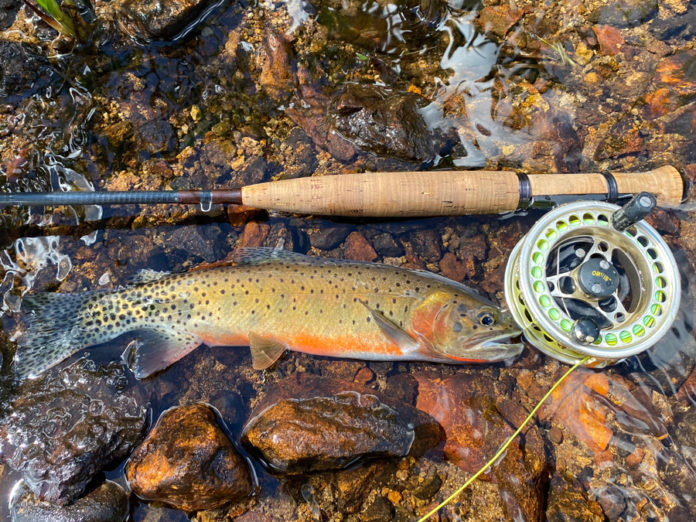Story and photos by Daniel A. Ritz
Editor’s note: Orvis joined Trout Unlimited in sponsoring Daniel Ritz’s attempt to complete the Western Native Trout Challenge in a single year. This is his final dispatch.
Last summer, my friend Jim Stiglich left me a voicemail that said, simply, “Hope you’re out there fishing hard, because fishing’s fun.” I jotted down his profound, understated quote because somehow I knew that his sentiment would be important to remember. That came to mind again and again as I drove the nine hours from Northern California back home to Idaho, after catching an Eagle Lake rainbow trout to complete the “Master Caster” class of the Western Native Trout Challenge.
When I reflect on my time fishing for and connecting with 20 native species in 12 states over the last five months, I think about how I would certainly do it all again, but if I knew then what I know now, I might have done things a bit differently. There is a delicate balance between mental discipline, physical skills and plain ol’ good fortune.
To be clear, I am only considered a “Master Caster” by the Western Native Trout Initiative, and I wouldn’t dare offer any real fishing advice. That said, I have learned a few things along the way that I’m happy to pass along to the next curious angler.
1. There Are More Fish In The Sea
If you find yourself stumped by an elusive or stubborn fish, don’t begin rapid-fire changing flies until the cows come home. Instead, just take a walk. Let it go. That fish earned another day. It’s not worth your sanity. Reel in and move to another spot. There will be more. Besides, in my extraordinarily unprofessional opinion, discovering what’s around the bend is a big part of the fun. Related tip: Before you leave for your trip, spend less time “practice” fishing and more time getting in shape. You’ll thank me later.
2. Know Your Confidence Combos

There were a few times during the course of the Western Native Trout Challenge when folks were surprised to hear I was fishing a dry or hopper-dropper setup. Often, native species are not difficult to catch, but they are often difficult to find. So, feel free to toss your favorite confidence combo. Mine’s an Amy’s Ant with an orange hotspot Frenchie. Why? Who knows. It just works for me. What you want are flies that might make a fish move, even if the match isn’t perfect. Whatever your go-to searching pattern is, make sure to stock up on your confidence combinations and have a few size options to ensure happy hunting.
3. Check Your Attitude at The Trailhead

If you want to pursue the Western Native Trout Challenge, evaluate what your fishing priorities are and how they are going to impact your pursuit. Are you usually the type to hunt down the biggest fish? If so, check yourself when casting for beautiful but tiny species, such as Gila or redband trout. Are you a northeastern brook-trout nut looking to add a fun twist to your trip to Alaska? Fair warning: if they call steelhead the fish of 1,000 casts, Alaskan lake trout on the fly might be the fish of 500. Take a second to consider what quality means to you, leave your daily home-water goals behind, and be present in your pursuit.
4. Be a Jack of All Trades

One of the most satisfying aspects of the Western Native Trout Challenge is the diversity you’re likely to encounter. Not only diversity of people, landscapes, weather, habitat and fish, but also a diverse range of fishing styles. Be prepared to present a fly in more ways than one. I can’t tell you how many times during the past five months I’ve been thankful that I’m a bit of a fly fisher of all trades and a master of none. In Alaska in search of lake trout and rainbows, you’re going to be “chucking and ducking” big flies on heavy lines. Make sure you practice that double-haul and maybe bring a helmet. Do you want to get your Lahontan cutthroat somewhere besides Pyramid Lake? You’ll need a supple small stream rod somewhere shy of 8 feet. Much more and you’re in for quite the afternoon picking yourself and the majority of your flies from the abundant streamside bramble. In my experience, you certainly don’t have to be an expert angler, but you should be ready to cast, swing, strip, and set in more ways than one.
5. ’Tis the Season

Living in southwestern Idaho, I am fortunate to have access and a moderate climate that allow for the pursuit of our native species most of the year. However, that is not the case across the entire West. If you have a particular species you’re interested in pursuing, be sure to look well ahead of time for seasonal accessibility. Some species have nonnegotiable times you can expect to tangle with them. For example, Apache, Gila, Lahontan, and California golden trout are species highly impacted by seasonal drought and wildfires. Your ability to catch Alaskan lake trout, arctic char, Eagle Lake rainbow trout, and bull trout are highly dependent on cold air, cold water, or both. Before making anything more frustrating than it has to be, I suggest taking a closer look at what fish come with more baggage than others and working from there.
The experience of the Western Native Trout Challenge is something that I will never forget and something that I cannot recommend enough to any curious angler interested in a new fishing experience. I fished hard, and I have enjoyed learning a few of these lessons the hard way. I hope you have found value in our #WesternTroutChallenge, which I’ve enjoyed sharing with you all.
And it’s been fun. It’s been very, very fun.
Daniel Ritz is a writer, angler, and Communications Manager at Ted Trueblood Chapter of Trout Unlimited.

Credit: Source link































